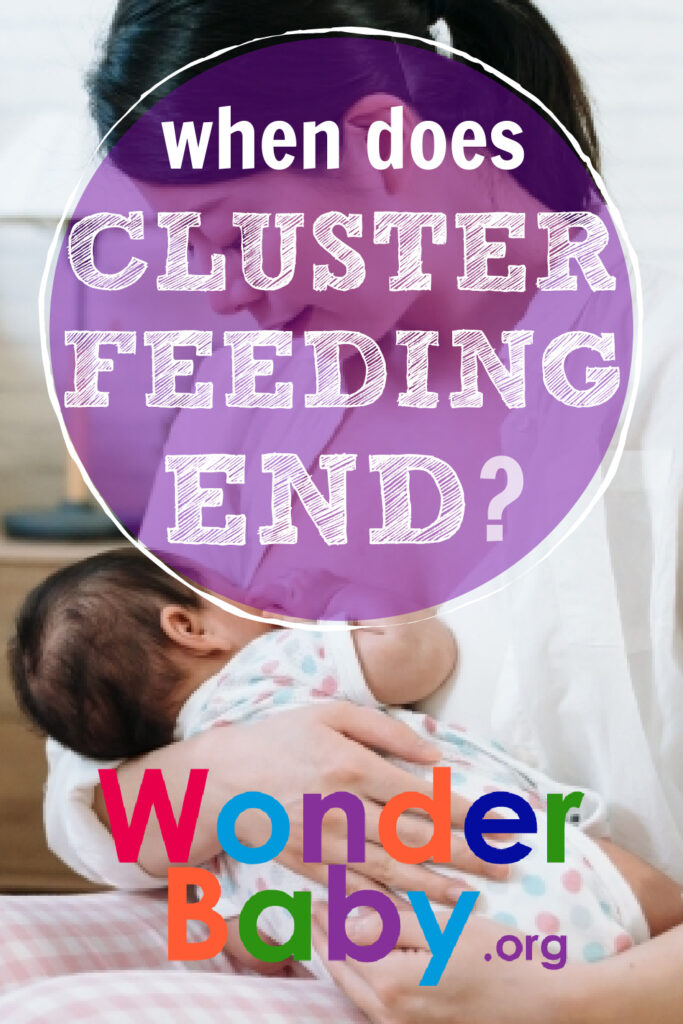When Does Cluster Feeding End?

- Cluster feeding is common in young babies and completely normal.
- The cluster feeding phase of a young baby’s life can be a real struggle for many parents.
- Although cluster feeding is common in young babies, if you or your baby are experiencing discomfort, call your doctor or a lactation consultant.
Breastfeeding a new baby can be a beautiful bonding experience between mother and child. It can seal the connection between you, build your baby’s trust, and make them feel loved and secure.
But breastfeeding can also, especially in the early weeks, be difficult to master and exhausting for new mothers. And one of the most tiring breastfeeding experiences a new mom — and her partner — may have to deal with is cluster feeding.
Cluster feeding can seem like a never-ending cycle of baby feeding and sleep deprivation. But the good news for new parents is that cluster feeding is only a phase in the life of a newborn baby and it does pass eventually.
What is Cluster Feeding?
Cluster feeding is a period in a young baby’s life when they feed very frequently, sometimes every hour, for a few hours a day. The cluster feeding newborn can make a new mother feel like she does nothing but feed her baby all day and all night. Just when she thinks she’s finished feeding the baby, they’re crying again and can only be soothed with more feeding.
According to the Centers for Disease Control, newborn babies in their first days will usually feed every one to three hours. At this point, they are taking in very small amounts of their mother’s milk in the form of colostrum. In the early days and weeks, cluster feeding helps a mother increase her milk supply and gives the baby a chance to practice sucking and swallowing milk.
As your baby grows, the time between feedings will last for longer stretches, from two to four hours. A baby in its first months will generally feed between eight and twelve times in 24 hours. Some feedings may be longer, others shorter.
But anywhere from three weeks to around three or four months, some babies will cluster feed. They may feed more frequently rather than less during certain times. They may start to feed every hour or for short bursts over several hours.
You may notice that this tends to happen at certain times every day, particularly in the late afternoon, early evening hours, or through the night. This behavior is known as cluster feeding.

When Does Cluster Feeding Start?
Generally, babies cluster feed around growth spurts. Three weeks, six weeks, three months, and six months tend to be the common cluster feeding ages. Many babies start to cluster feed in their first few days of life as they take in colostrum and then breast milk when mom’s milk comes in.
Does Cluster Feeding Mean My Baby Isn’t Getting Enough Milk?
One worry that parents have when their baby cluster feeds is that feeding at frequent intervals is a sign that their baby isn’t well or that something is wrong. They worry that cluster feeding might be an indicator that there is a problem with their baby’s digestion, that their baby is not getting enough calories, or that mom isn’t making enough milk.
The Academy of Breastfeeding Medicine (ABM) recognizes cluster feeding as “several short feeds close together” and states that this infant behavior is totally normal. Often a breastfed baby will begin to cluster feed during growth spurts. They may cry a lot, demanding to feed and be very fussy.
The ABM suggests that parents and practitioners should observe newborn cluster feeding to make sure that excessive fussiness and marathon feeding are not the results of some other cause.
Call your pediatrician or lactation consultant if you are worried or if you notice any of the following:
| Issue | Possible Cause |
| Drop in the number of wet diapers despite cluster feeding | Possible sign of low milk supply |
| Fussiness and crying that continues unless baby is breastfeeding | Possible signs of colic rather than going through a growth spurt |
| You are breastfeeding non-stopBaby continues to show signs of hunger even after feeding | Possible issues with milk supply or with the mechanics of latching and sucking Baby may not be getting enough milk |
| IrritabilityFeverChange in behavior | Call your doctor right away to rule out illness |
| Baby is not gaining weight despite frequent feeding | Baby may not be getting enough calories |
| Baby has a yellow tinge to the skin and whites of eyes | Possible jaundice which requires treatment |
But if your baby is showing normal weight gain, your milk production is stable, and you’ve ruled out colic, then chances are your baby has entered a cluster feeding phase.
Does Cluster Feeding Happen Because of Trouble Latching?
A baby who is latching and unlatching repeatedly may be taking a long time to feed or feeding frequently for other reasons not related to cluster feeding. For example, gas, low milk supply, oversupply of milk, distraction or discomfort can all lead to poor latching.
Call a lactation consultant for advice and support if your baby is showing discomfort while feeding.

How Long Does Cluster Feeding Last?
Every baby is different, so how long cluster feeding lasts will depend on your baby. Many babies never cluster feed at all. But most newborn cluster feeding sessions tend to occur around growth spurts.
Cluster feeding times can range from ten to fifteen minutes at a time for two to three hours at a stretch. This pattern can occur several times throughout the day, several hours at a time, or during certain periods of the day when babies tend to be fussier. Cluster feeding periods can happen for several days at a time and then taper off.
Generally, cluster feeding stops around your baby’s six-month mark when your baby is no longer a newborn and sleep and feeding start to fall into a regular pattern.
How Will I Survive My Baby’s Cluster Feeding?
It’s normal and completely understandable if your baby’s demands to feed feel overwhelming. Cluster feeders can be very challenging for breastfeeding parents, especially if the newborn cluster feeding sessions are happening at night or in the early hours.
But the good news is that cluster feedings will pass eventually as your baby develops and gets into a more predictable feeding schedule.
You may be feeling the effects of sleep deprivation and physical exhaustion. You may also be dealing with physical discomfort due to cracked nipples or lipstick nipple. Or you may still be recovering from birth or c-section. And you may have other children at home who also need your time and attention.
This is when a breastfeeding partner can step in and really help. Share these cluster feeding tips for breastfeeding partners with your partner:
- Take care of jobs like buying groceries, meal preparation, laundry and house cleaning.
- Make sure breastfeeding areas of your home are stocked with water and snacks that are easily accessible.
- Ask mom what essentials need to be readily available and make sure that she doesn’t run out of things like nursing pads and pumping accessories.
- If you are mixed feeding, take a shift of bottle feeding expressed milk so that your partner can rest.
- When the baby isn’t feeding be sure to take shifts changing, holding, playing, and putting your baby down for naps.

Related Posts

Breastfeeding, Sleep
Sleep and Breastfeeding: A Comprehensive Guide for Nursing Moms
Many people assume breastfeeding and sleep training don’t go together, but it is possible to help your baby sleep better while continuing your breastfeeding journey.

Breastfeeding
Comfort Nursing: Pros, Cons, and How to Stop
Find out what comfort nursing is, when should you worry about it, and how to stop or limit your baby's comfort nursing (especially at night!).

Breastfeeding, Product Reviews
5 Best Breastfeeding Chairs for Nursing Moms of 2023
Whether you want a gentle rock, a smooth glide, or a cozy cuddle to soothe your baby to sleep, you’ll have your pick of the best breastfeeding chairs on the...